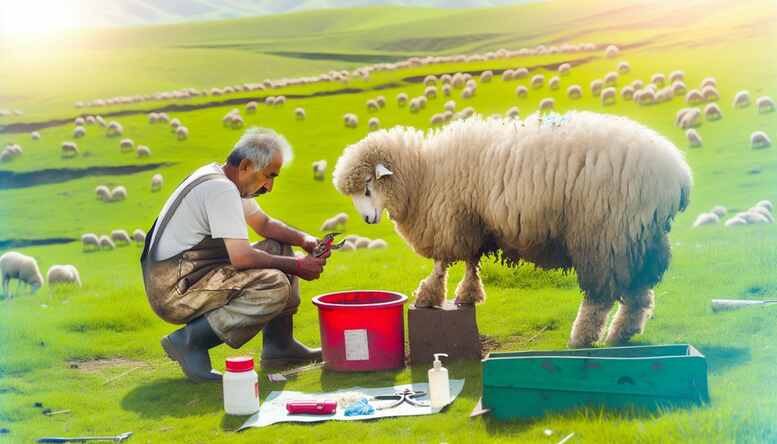Sheep husbandry requires careful attention to several key areas for optimal flock health. Proper nutrition, adequate shelter, and regular health monitoring form the foundation of responsible sheep management. Owners must understand the specific needs of their breed while implementing effective parasite control strategies and safe handling practices. With predator threats and seasonal challenges constantly evolving, even experienced shepherds benefit from reviewing essential care protocols. The difference between thriving sheep and merely surviving ones often lies in these fundamental practices.
Provide Proper Nutrition and Clean Water
Providing proper nutrition and clean water forms the foundation of successful sheep husbandry. Sheep require a diet primarily consisting of quality pasture or hay, with specific nutritional needs varying by age, breed, and reproductive status.
Regular assessment of forage quality helps determine when feed supplements become necessary. During pregnancy and lactation, ewes need additional protein and energy sources. Minerals, particularly copper in controlled amounts, support overall health.
Water quality directly impacts sheep health and productivity. Fresh, clean water should be available at all times, with troughs cleaned regularly to prevent algae buildup. During winter, prevent freezing by using heated water sources or breaking ice twice daily.
Create Appropriate Shelter and Grazing Areas
While sheep are resilient animals that can tolerate various weather conditions, appropriate shelter and well-designed grazing areas remain essential components of their overall care. Shelters should provide protection from extreme elements, particularly during lambing season, while allowing proper ventilation.
Implementing pasture rotation prevents overgrazing and reduces parasite loads in the soil. Dividing grazing land into sections enables grass recovery and maintains nutritional quality. Fencing must be secure, serving the dual purpose of containing sheep and offering predator protection.
Wire mesh fencing, guardian animals, and night penning are effective predator deterrents. Regular pasture assessment ensures vegetation remains adequate and hazardous plants are removed.
Implement Regular Health Checks and Preventative Care
Because sheep are susceptible to various health issues, regular monitoring and preventative care form the cornerstone of responsible flock management. Shepherds should establish a consistent schedule for examining each animal, checking for signs of illness, parasites, and abnormal behavior.
Maintaining health records for individual animals enables tracking of treatments and identifying patterns of concern. Shepherds must monitor vaccination schedules carefully, ensuring timely administration of required immunizations against common diseases like clostridial infections and foot rot.
Routine hoof trimming, dental checks, and wool assessments should be incorporated into health protocols. Consulting with a veterinarian to develop a tailored preventative care program optimizes flock health outcomes.
Master Safe Handling and Restraint Techniques
Since sheep can become stressed or injured during handling, proper restraint techniques are essential for both animal welfare and handler safety. Shepherds should approach animals calmly from the side rather than directly behind them, which can trigger flight responses.
When restraining sheep, use proper body positioning—one hand under the chin and the other at the rear. For procedures requiring immobilization, sitting sheep on their rumps immobilizes them safely.
Safe transport methods include appropriate stocking densities and non-slip flooring. Always minimize stress during handling by working quietly, avoiding sudden movements, and utilizing familiar handling areas when possible.
Establish an Effective Parasite Management Program
Taking care of sheep by establishing an effective parasite management program represents one of the most critical aspects of sheep health maintenance. Internal parasites pose significant threats to productivity and survival, particularly in young lambs and stressed animals.
Implementing rotational grazing techniques allows pastures to remain parasite-free for longer periods while interrupting parasite lifecycles. Sheep should be moved to fresh paddocks before grass height falls below three inches.
Regular fecal egg count monitoring provides critical data to guide strategic deworming decisions rather than relying on calendar-based treatments. This approach prevents parasite resistance while ensuring treatments occur when genuinely needed. Testing representative samples from each flock segment enables targeted intervention for heavily parasitized animals.
Understand Breeding and Lambing Management
Successful sheep production hinges on mastering the fundamentals of breeding and lambing management. Producers should strategically plan conception timing to align with optimal forage availability and market demands. Maintaining proper ewe body condition scores of 3-3.5 before breeding significantly improves ovulation rates and embryo survival.
During gestation, adjust nutrition to support fetal development while preventing pregnancy toxemia. Prepare clean, draft-free lambing areas with necessary supplies two weeks before expected births. Monitor ewes closely during labor, intervening only when necessary.
After lambing, ensure lambs receive colostrum within six hours and verify strong maternal bonding occurs. Careful management during this critical period dramatically improves lamb survival rates.
Maintain Proper Hoof Care and Trimming
Regular hoof care forms the cornerstone of sheep health maintenance, preventing costly mobility issues and infectious diseases. Shepherds should establish a schedule for regular hoof inspection, examining each animal at least every 6-8 weeks, more frequently in wet conditions.
Proper hoof trimming technique requires sharp tools and careful attention to hoof structure. Trim only overgrown areas to create a flat, level surface that allows even weight distribution. Never cut into the sensitive pink tissue, as this causes bleeding and potential infection.
During inspections, watch for signs of foot rot or scald, treating affected animals promptly and separating them from the flock.
Shearing and Wool Management Essentials
Though many novice shepherds underestimate its complexity, proper shearing and wool management directly impacts both sheep health and potential farm income. Professional shearing should occur annually, ideally before warm weather arrives, using correct wool clipping techniques that prevent nicks while maintaining fleece integrity.
Post-shearing, fleece sorting and grading becomes essential for maximizing value. Separate wool by quality, removing contaminated sections and categorizing by fiber diameter and length. Store clean fleece in breathable containers away from moisture and pests.
During extreme weather following shearing, provide shelter to prevent hypothermia or sunburn until sufficient regrowth occurs, typically 2-3 weeks post-shearing.
Recognize Common Sheep Diseases and Their Symptoms
While proper wool management safeguards sheep during shearing, shepherds must remain vigilant about health threats year-round. Regular flock health monitoring enables early detection of common ailments such as foot rot, characterized by limping and foul-smelling hooves, or pneumonia, which presents with labored breathing and nasal discharge.
Caseous lymphadenitis manifests as abscesses in lymph nodes, while acidosis occurs when sheep consume excessive grain, causing lethargy and bloating. Mastitis in ewes produces abnormal udder inflammation and discolored milk.
Disease prevention strategies should include vaccination protocols, quarantine procedures for new animals, and maintaining clean feeding areas to minimize pathogen exposure.
Develop a Relationship With a Livestock Veterinarian
A successful sheep operation depends on establishing a strong relationship with a livestock veterinarian who specializes in small ruminants. Farmers should schedule regular farm visits for preventative care rather than waiting for emergencies. This proactive approach allows veterinarians to identify livestock vaccination guidelines specific to local disease risks and flock needs.
Producers should coordinate with local extension services and their veterinarian to develop comprehensive health programs. Extension services often provide educational resources that complement veterinary advice. The veterinarian becomes an invaluable partner in maintaining flock health, offering expertise on nutrition, parasite control, lambing assistance, and regulatory compliance. This relationship ultimately improves animal welfare and farm profitability.
Read More: What is Chris Brown Doing Now?



